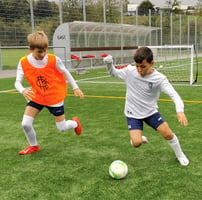Children can give free rein to their creativity in 1 vs. 1 games. In direct duels, they playfully...
Levers - achieve a lot with little effort!
In mechanics, heavy loads can be moved with small forces thanks to the law of leverage. We would like to transfer this to football training! Whether adapting existing behaviors or with a little more time, a lot can be moved. We would like to introduce you to a few "levers" that are particularly helpful in children's and youth football.

Developing instead of preparing the game
On the sidelines, you often see the classic game preparation: a little movement, a passing attack, a round of ball holding, 2-3 shots on goal and sprinting. And of course this is only for the players in the starting line-up. But if we want to train the player holistically, we could use these 30-45 minutes more intensively for everyone. Because in 10 years' time, nobody will be interested in what the result was, but how good is the individual player? If we consider and use 45 minutes as training time before each game, this results in 150 additional training sessions for the individual player (30 games per year times 10 years times 45 minutes), which means almost 1 year of training, or a 10% increase, depending on the number of training sessions per week! Should this be sacrificed for one game? We think: No! In the short term, a game may be lost, but in the long term, our players have more skills and chances of success.
Managing parents' expectations and ideas
Parents have a huge influence on the development of the players and the mood of the team. Opinions from parents can form prejudices in the children, result in incorrect tactical/technical understanding or cause pressure through match analysis. All of this ultimately falls back on the coach and makes training and the game more difficult. It is therefore important to communicate transparently and openly before the season so that expectations are clear and conflicts are kept to a minimum. Parents should not discuss the child's performance, but only ask the child if they are having fun and enjoying themselves. Nevertheless, the environment should understand what the coach expects from the players and not be taken aback, e.g. if the player at the back only dribbles on the coach's instructions in order to encourage courage. Accordingly, the way in which the children are trained must be explained to the parents in order to prevent misunderstandings.
Allow voluntary breaks, do not force them.
Standing still is a step backwards. How often have young people had to wait their turn to take a shot on goal? During a Coach-the-Coach consultation, we experienced that a participant was only active for 24 minutes in 90 minutes (including fetching the ball). If you calculate the journey there and back, as well as dressing room time, that's almost 170 minutes of "waiting and drinking tea" for 24 minutes of activity. Every toddler can organize this themselves at home. Why does this happen? Quite simply, as a coach, there is a need to get everything right and to observe and comment on every single action. However, this is not in the interests of the players because there is too much idle time. Remember: every supposedly incorrectly performed action is movement (beneficial to health), contains coordinative elements (develops the nervous system) and builds negative knowledge (helps to find solutions). This is why we recommend setting up several exercise stations and letting participants try things out for themselves rather than conducting a frontal monologue and qualitatively correcting each execution. Has anyone ever learned to drive by just talking and watching videos? Have fun with the training.
Grafik-Quelle: https://de.universaldenker.org/formeln/1236 - Vielen Dank!



